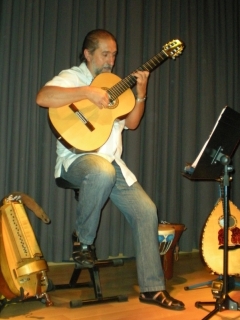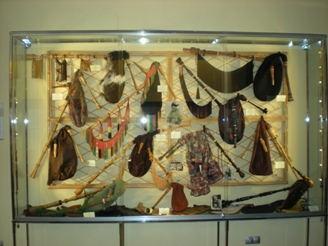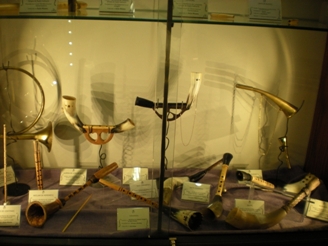Castilla y León is Spain’s autonomous community in the central north part of the Iberian peninsula (Spain and Portugal). Paco DÍEZ is one of the strongest voices in the world of folk music in this Castilian region. He is also an artist who is making amazing personal efforts to support the traditional music of his area, but from several other places as well. In August 2011, we had the chance to meet him personally, and to get unforgettable lessons from Paco’s knowledge, also materialized in his magnificent Classroom-Museum-Auditorium.
La Bazanca and other projects
Paco started his career in folk music in 1975 mostly playing traditional rhythms from his birth place region, Castilla y León, a Spanish autonomous community, that comprehends 9 provinces and that has borders with Portugal, and the neighbour communities of Galicia, Asturias, Cantabria, Basque Country, La Rioja, Aragón, Madrid, Castilla-La Mancha and Extremadura. During his early years, he also had the chance to learn and research on the music traditions of the north Castilian region, while working with another important figure in this part of Spain: Joaquín DÍAZ.
In 1980, Paco DÍEZ created the band LA BAZANCA that has lasted until today (2011), and where several folk musicians have been playing together with him. In LA BAZANCA, Paco has been singing and playing instruments such as guitar, gaitas (Spanish bagpipes), mandola, zanfona (hurdy-gurdy) and percussions. The repertoire is mostly based on traditional songs from Castilla y León, in many cases compiled by Paco during his field research work on several villages of this region.
His activities on folklore and musicology extended Paco’s knowledge on other parts of Spain, and also Portugal, but specially on the music of the Jewish peoples that were forced to leave Spain in 1492. The music of the communities of Jews that have kept the Spanish language and have settled in several countries in the Mediterranean basin, the Balkans and several cities in Europe is known as Sephardic. This is derived from the old name given in Hebrew language to the Iberian Peninsula (Spain and Portugal) : Sepharad.

Paco has been performing in concerts and lecturing in conferences about Iberian music traditions and instruments along the last thirty years, in a total of more than 2500 events in more than 17 countries including: Portugal, France, Italy, Germany, Greece, Sweden, Poland, Bulgaria, Israel, Morocco, China, USA and almost all countries in Latin America.
After all these years of playing and teaching folk music, Paco has decided to take another big step forward in favour of traditional music.
Paco Díez’s Museum, Classroom & Auditoriums
The concept that Paco has created (and self-financed) in his residence in the village of Mucientes (Valladolid province) probably is the most positive and generous that I have known so far in the traditional music of Spain. He has built a group of two floor interconnected modern buildings that host a multifunctional set of spaces fully integrating :
His idea is very simple and probably the dream of many folk musicians : to literally live surrounded by his collections, and to have the necessary space for his professional work (as researcher, a teacher and a musician), for his family life, and even more to invite and host as a friend all of the many artists that he enjoys playing music with.

Paco’s house and museum is located in an area of the village of Mucientes close to a magnificent 16th century built stone church (San Pedro Apóstol), and right next to a quarter that keeps lots of old wine cellars. These bodegas were built underground in man-made caves that were excavated from the 16th until the 18th century, and it is where the people from the village used to bring the grapes to press them and extract the juice that was then fermented and stored in barrels.
The ticket to Paco’s museum (fully accessible for handicapped visitors, including ramps, elevators, bathrooms) will cost you 5 Euros, and let’s see what you will be able to experience there. It consists of a collection of up to 480 musical instruments, mostly typical from Castile, but also from other parts of Spain, Portugal and the rest of Europe. His collection of bagpipes may be the best in the whole of Spain. It is displayed in two rooms, one of them grouping all kinds of bagpipes from Portugal and Spain meaning: Portuguese gaitas de foles (from Tras Os Montes, Terra de Miranda, Alto Minho), gaitas from Galicia, Asturias, Sanabria, Aliste, León, La Rioja, gaita de boto from Aragón, sac the gemecs from Catalonia. The second room has : great Highland bagpipes & Lowland pipes from Scotland, English pipes from Northumberland, Uilleann pipes from Ireland, Binious from French Brittany, veuze from Vendée, boha from Gascony, cornamuses, crabo & cabrette from central France, torupill from Estonia, gaidas from Bulgaria, duda from Hungary, sackpipa from Sweden, etc.. And also mezoued or zoucra from Tunisia and Saudi Arabia.
Paco has accumulated this great collection along his 30 year career in folk music by both purchasing instruments and exchanging them with other collectors and makers, such as his friend Luis Angel Payno, who also actively cooperates with Paco for the enlargement of the instrument collection in the Museum-School (FolkWorld has already written about Luis Payno in the previous FolkWorld issue).[45] Another two big co-operators and great friends are the Galician gaita maker Antón Varela, and also the researcher, collector and musician Juanma Sánchez.
But what makes absolutely enrichening the experience of visiting Paco’s museum is that he will not just personally explain the history, the traditions, the making and playing techniques of most of them, it is that he will actually play them for you, and even let you try some of them. Depending on Paco’s work plan for the day, it may happen that at the end of the visit he will open the door of the indoor auditorium next to the museum, and invite you to listen to a small concert performed by himself. He will usually sing and play folk songs from central Spain, but he does not just have a great deep voice and is a refined guitarist, he is also very skilled in playing different instruments (rebecs, three holed flutes, hurdy-gurdy, percussions,...) and his repertoire extends to trad tunes sung in Spanish, Galician, Catalonian, Basque, Ladino (Spanish-Jewish), Portuguese, French, English,...
Paco DÍEZ’s knowledge in history, languages, music, traditions,... is big, but most of all he has a deeply sincere willingness to share it openly and generously with the audience, and making full use of communication abilities that will immediately capture your attention and that include his Castilian sense of humour.

|

|
Artists, Teachers, Friends
Paco has also a continuous calendar of folk music concerts taking place in his indoor (winter) and open air (summer) auditoriums (for up to 100 people each), and the activities taking place there are of two kinds :
All the info about the past and upcoming concerts is presented @ www.aulamuseopacodiez.net/programacion.
Photo Credits:
(1)-(5) Paco Díez & Aula-Museo de instromentos musicales ibericos
(unknown).